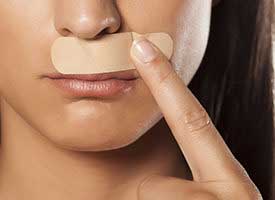Skin tags: how to deal with them

A skin tag is a benign skin growth that usually forms in areas where the skin rubs or in folds of the skin such as the neck, armpits, and groin. Skin patches can also appear on the face, especially on the eyelids. Microscopically, skin marks are composed of a fibrovascular nucleus, fat cells and a benign epidermal covering. These lesions are usually small, grow in clusters, and may hang from the skin on a thin stalk that usually has a stalk. Bumps on the skin often cause itching and irritation when rubbed against clothing.
A skin tag is also called an acrochordon, cutaneous papilloma, skin tag, fibroepithelial polyp, molluscum fibroma, pendulum fibroma, soft fibroma, or Templeton’s skin tag. Their size varies from 2 millimeters to 1 centimeter, and some increase in size up to 5 centimeters.
According to the National Institutes of Health, approximately 46% of the population suffers from skin tags, and this is one of the most common benign lesions seen in dermatology. Skin tags are extremely common: more than 3 million cases are diagnosed annually. As patients get older, they develop more skin tags.
Usually growths appear on such areas of the body:
- armpits;
- under the breast;
- groin;
- face and eyelids;
- neck;
- upper chest;
- vagina;
- anus.
Reasons for the appearance

Although the exact cause of the skin tags is unknown, dermatologists have noticed that they are formed from a collection of collagen and blood vessels trapped in areas with thicker skin, and are activated to grow in areas where the skin rubs. Some studies show a genetic predisposition for skin tags; If you have a family history of skin tags, you are also more likely to develop them. More often among women than among men, which indicates a probable hormonal relationship. Pregnant women are also more likely to develop them. Skin tags are associated with obesity, high levels of growth factors, high cholesterol, hypertension, insulin resistance, some types of HPV, and changes in estrogen and progesterone levels.
Human papillomavirus (HPV)
Human papillomavirus, HPV types 6 and 11, which are low-risk human papillomavirus, have been linked to the evolution of skin tags. If you have skin marks in your groin, genital, or anal area, it is recommended that you remove those lesions and test for HPV. Although skin tags are considered benign, their clinical association with HPV requires removal in these sensitive areas, as some high-risk papillomaviruses are associated with skin cancer.
Diabetes
Skin tags can also indicate other health problems such as diabetes. When you have diabetes, your blood glucose levels can also cause hormonal imbalances. Hormonal fluctuations caused by blood glucose levels can affect cellular metabolism in the skin. In type 2 diabetes, insulin levels are too high. Due to the inability of the skin to produce healthy cells, skin marks are formed. The formation of skin marks will continue until the body regulates itself and the glucose level stabilizes. Although diabetes can cause skin blemishes, not everyone with diabetes gets them.
Obesity
Not only does the diagnosis of obesity come with a host of other health problems, but skin tags are also on the list as well. Obesity can cause hormonal fluctuations that can lead to the development of skin marks. In addition, obese patients may experience more and more skin friction in areas prone to skin marks. Patients with type 2 diabetes mellitus are also more susceptible to the development of skin marks and elevated blood insulin levels.
Friction
Skin friction is a common cause of skin marks, especially around the neck, underarms, under the breast, and under the skin folds in overweight patients. Wearing tight-fitting clothing or engaging in activities that rub your skin against each other can cause skin marks, especially in the groin and buttocks.
What syndromes are associated with growths
Brit Hogg Dub Syndrome
It is a very rare genetic disorder that usually occurs in children and is associated with the development of skin marks, predominantly on the face and upper body. It is also associated with skin tumors, including multiple fibrofolliculomas and trichodiscomas. These patients may also develop renal and colon carcinomas.
Polycystic Ovary Syndrome
Polycystic ovary syndrome is a hormonal disorder that causes the ovaries to enlarge to form small cysts. Patients can suffer from many dermatological conditions such as acne, acanthosis nigricans, abnormal hair growth, and skin lesions.
Removal methods
Skin tags are common benign lesions that do not need to be removed. However, since skin tags tend to grow in clumps, many patients want to have them removed for cosmetic reasons, especially on the eyelids. In addition, since they also tend to form in areas of skin that rub against each other, many patients want to have them removed because they itch or can cause bleeding when scratching.
Electrical desiccation
Electrodesiccation is a popular method for skin tag removal. The method uses a tiny needle that delivers electricity or heat to remove skin marks. The current cauterizes the skin tags, which eventually crust over and heal. Ointment with bacitracin or Aquaphor is applied to the treated area after removal for several days.
Cryotherapy
For small skin tags, cryotherapy, which is the application of liquid nitrogen, is usually sufficient to safely remove the lesions. This procedure is quick and relatively painless. Liquid nitrogen is around 320 F and is very cold. On contact with skin, the gas freezes the skin tag. Due to the high freezing point of liquid nitrogen, it should only be used by a dermatologist, as it can cause severe burns if used incorrectly. The skin tag may blister and crust over several days after applying liquid nitrogen. Proper wound care is essential to prevent scarring. Due to the potential for scarring, liquid nitrogen is not the preferred treatment.
Excision
Other removal methods should be considered for removing large skin tags, as larger growths usually have a thicker stem. For larger skin marks, surgical excision is usually recommended in addition to electrodesiccation. Before the procedure, the skin can be prepared with a local anesthetic or injection to numb the treated area. Once the area is numb, the skin tag can be removed with sterile surgical scissors or a surgical blade. After excision of the build-up, the area should be cauterized with a hyprecator. Since the skin tags have their own blood supply, moxibustion will stop further bleeding by closing off the blood vessels.A skin mark, or acrochordon, is a benign skin growth that usually forms in areas where the skin rubs or in folds of the skin such as the neck, armpits, and groin. Skin blemishes can also appear on the face, especially on the eyelids.
Do not try to remove yourself at home
There are many DIY home remedies, online skin tag removal kits, and videos on skin tag removal, such as showing you tying floss around a build-up to remove it. Other home skincare treatments are also recommended, such as applying tea tree oil or apple cider vinegar to the skin tag to remove. When it comes to removing skin blemishes at home, there is an associated risk of infection and it is recommended that these lesions be removed in the doctor’s office. Because skin tags have their own blood supply, you run the risk of causing profuse bleeding if you try to remove them yourself. It is best to seek medical attention and consult a dermatologist to make sure these lesions are benign. and remove these skin tags in a sterile medical environment. Besides bleeding and infection, other associated risks include scarring and blistering.
How to prevent the occurrence
While skin tags can be caused by various health conditions, reducing friction can certainly help prevent tags from developing. In addition to preventing friction, maintaining stable insulin levels and a healthy weight can also help prevent skin markings.
Difference between genital tags and HPV
Skin tags can also appear on the genitals, and a dermatologist must examine them to determine if they are indeed skin tags and not a form of a sexually transmitted disease (STD). Spots on the genitals, while painless, can cause discomfort, itching, or bleeding. Skin patches in the genital and groin areas are also more prone to clumping and often go unnoticed. Most people choose to remove skin tags on their genitals for cosmetic reasons. In addition, due to the location of these skin tags, concern about possible STDs is a motivating factor for removal.
Diagnosing of skin tags
A dermatologist and other board-certified healthcare providers can determine if a skin lump is indeed a mark or some other type of lump.
Although skin tags are benign, there have been rare cases of skin cancer developing inside skin tags. There are other skin lesions and skin conditions that look similar to skin tags. Such as seborrheic keratosis and warts, and a trained dermatologist is needed to tell the difference. Any new skin lesions or lesions when removed should be sent to the laboratory for further histological examination and diagnosis.






